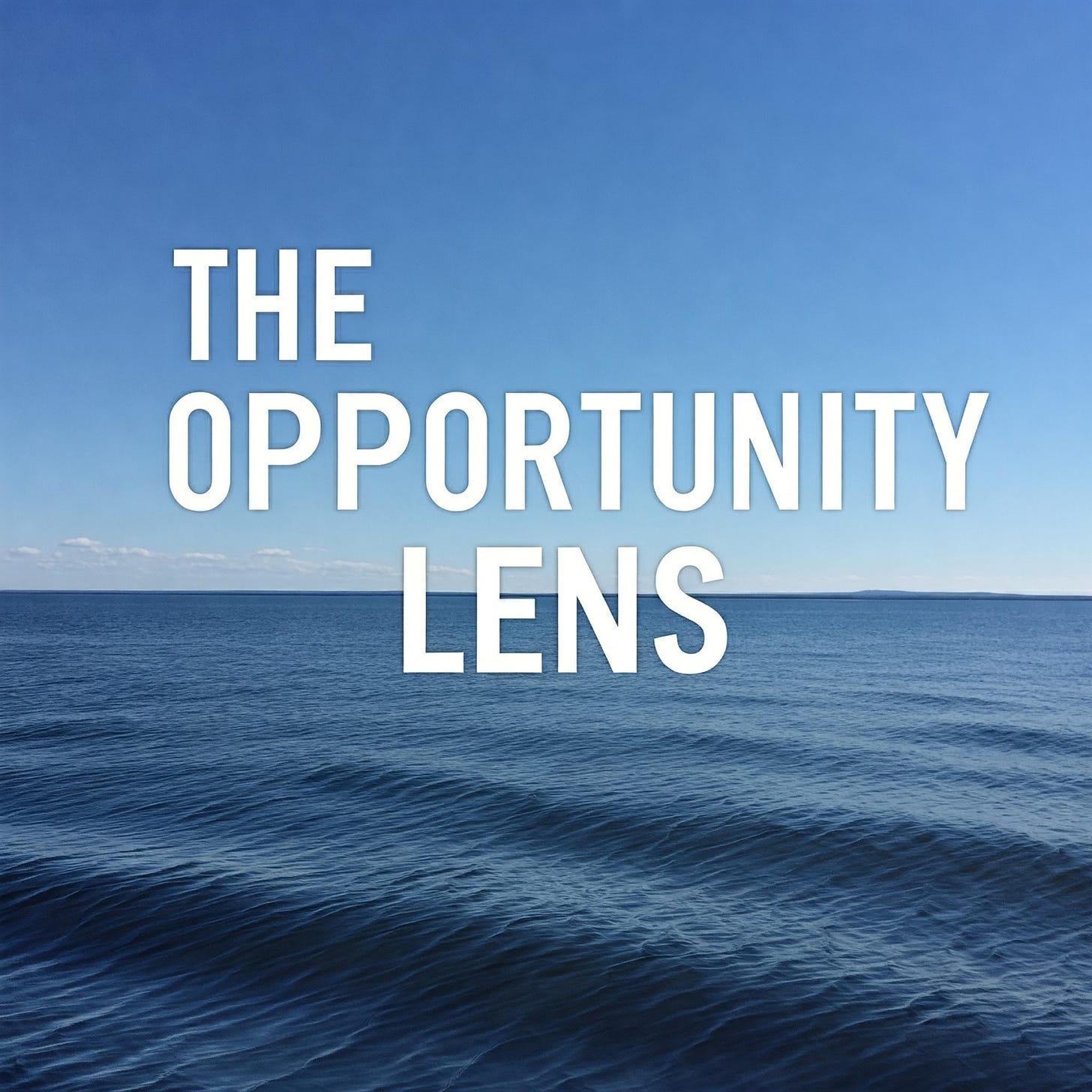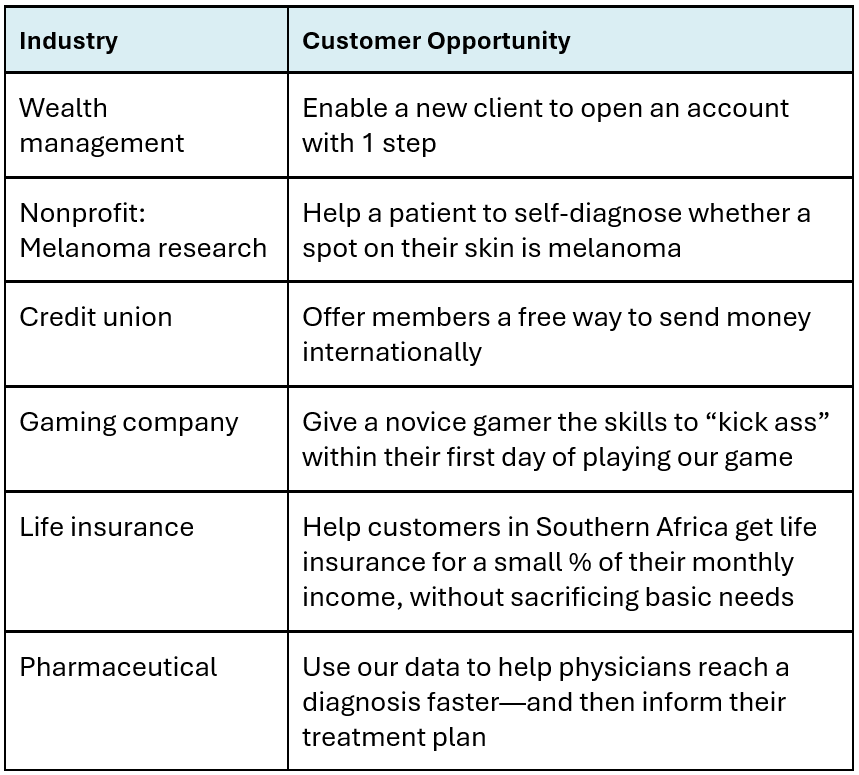Sorry for delay in this post. I’ve been knocked off schedule by a bout of Lyme disease, trying to keep up with client projects while I wait for the antibiotics to kick in.
With luck, I will be back to posting a new article or video every 2 weeks.
Enjoy!
Picking Up Where We Left Off…
In my last two articles, I introduced “the problem lens” as a guide to thinking about strategy in terms of problems we aim to solve—rather than solutions we expect to build.
I explained the power of defining strategy through the problem lens, with examples of both customer problems and business problems.
But I ended the second article with a challenge:
By its nature, the problem lens will tend to steer your thinking toward your current customers and your current business.
This can allow you to miss opportunities for innovation that serves new kinds of customers or unlock growth in new directions.
How can we overcome this inherent bias of the problem lens?
In this article, I want to explain how we can expand our strategic roadmap by deploying a second lens: the opportunity lens.
The Opportunity Lens
The second lens through which we can define our strategic priorities is the opportunity lens.
This entails thinking about strategy in terms of new ways to create value, both for customers and the business.
The power of the opportunity lens is that it can push you to look beyond your current business and think about strategy more expansively.
Let me give an example.
When Imran Haque led the early digital transformation of Zoetis, it was an animal health business active solely in pharmaceuticals. Haque identified diagnostics (for both pets and commercial livestock) as an important strategic opportunity for growth. But Zoetis had no role in diagnostics. Entering this market was not a solution to any current problem, yet it was a compelling opportunity to create value.
Haque was following an important path to value creation.
In the digital era, many of the biggest breakthrough products have come from pursuing a clearly defined opportunity to create new value.
When Apple began work on the iPod, Steve Jobs’s vision was to give the customer “1,000 songs in your pocket.”
When Amazon began work on what would become the Kindle, its ambition was to offer “every book ever printed, in any language, all available in less than 60 seconds.”
These were each incredible strategic opportunities to pursue, but they were not exactly pressing problems where Apple’s or Amazon’s customers were crying out for a solution!
When looking to create something truly new to market, boundary-pushing ideas are more likely to be discovered with an opportunity lens.
Are You Selling Painkillers? Or Vitamins?
Another way of thinking about this comes from the world of venture capital.
When listening to start-up pitches, VC investor VC Kevin Fong would famously ask entrepreneurs, “Are you selling painkillers or vitamins?”
In other words, are you creating a product that will solve a pressing problem for the customer?
Or will your product give the customer a better life in ways they may not yet know they want?
The common investing wisdom is that “painkillers” have better odds of success. Indeed, it is much easier to market such a product, precisely because customers understand its value immediately and see why they would want it.
On the other hand, there may be a bigger upside if a start-up can succeed with a “vitamin.” While it will be harder to introduce a product no one was asking for, if you succeed in addressing a real unmet need, the result could be a breakthrough product with little competition.
An Opportunity Is Not a KPI
As we make use of the opportunity lens, it is important to remember what a strategic opportunity is and what it is not.
A strategic opportunity is not a KPI or an annual goal for your preferred business metric. (“Grow top-line revenue 20 percent this year” is NOT a strategic opportunity.)
Nor is a strategic opportunity a solution you have already decided on. (NOT “build a virtual reality headset with longer battery life.”)
Rather, a strategic opportunity is a focused idea about the value your business could create and where it could compete. (For example, “create a VR meeting experience for designers that is better than being in the same conference room.”)
Whose Opportunity Is It?
Just as with problems, we can think of strategic opportunities from the point of view of the customer or the business.
Customer opportunities focus on ways to create new value for a specific customer. Think of the vision statements for the iPod and the Kindle.
In the table below, you can see examples of customer opportunities from companies that I have led in strategy development workshops.
Whereas customer problems address an evident point of friction or pain, customer opportunities produce an unexpected benefit or delight. This quality of unexpected delight is critical to theories of customer satisfaction.
The Kano model, for example, distinguishes product benefits that the customer values, demands, and expects versus benefits called “delighters,” which are unexpected but create the greatest excitement among customers when delivered.
Business opportunities, on the other hand, focus on new growth and expansion for the business.
Recall Zoetis identifying an opportunity to expand into the growing animal diagnostics business.
In YouTube’s early years as part of Google, Susan Wojcicki helped set a goal to achieve 1 billion hours of watch time per day—a 10x growth from their current level.
Amazon Web Services (AWS) began as an opportunity for the retailer to generate revenue from its new IT infrastructure by renting it to other companies as a service.
In the next table, you can see examples of business opportunities from companies in my strategy workshops.
Five Tips to Defining an Opportunity
I have seen five powerful ways that companies define strategic priorities with the opportunity lens:
• Customer delight statement—Try describing an unexpected and delightful experience to create for the customer. Bezos’s dream for the Kindle was “every book ever printed, in any language, all available in less than 60 seconds.”
• Attractive market with a right to win—Find a large or growing market to enter, one where your business has a built-in advantage. For Zoetis the opportunity to “enter the diagnostics business” meant selling to an existing base of customers, one that it was already serving with treatments and vaccines.
• Solve your own problem, then solve it for someone else—An innovative Hawaiian consumer brand sees shipping to its overseas markets as the biggest constraint on growth. By launching its own freight shipping service, it could vertically integrate its own business, and simultaneously help other local brands reach a broader market beyond Hawaii.
• New capabilities with clear application to your business—Look for new skills or emerging technologies that are relevant to an important part of your business model. Amazon chose to invest in robotics because of a specific application: picking products off warehouse shelves. More recently, drug makers have invested in machine learning because of its specific application to key steps in the drug discovery process.
• 10x stretch goal—Try envisioning value creation at scale, not just incremental improvements. “Grow YouTube watch time to 1 billion hours a day” was a business opportunity that drew on one of Google’s core principles, to “think 10x, not 10 percent.” Similarly, the Gates Foundation defines ambitious goals for public health by interviewing doctors and pushing them to think big, asking, “What would you do if you had unlimited resources?”
When defining opportunities, push yourself to think big about what matters most.
Remember, strategy is about defining your top priorities for growth, which must rise above all others!
Using Two Complementary Lenses
It is important to realize that problems and opportunities are two complementary lenses for looking at strategy.
In fact, a problem and an opportunity may just be two ways of describing the same idea. For Zoetis, entering the diagnostics market was a clear business opportunity. But it could also be described as a customer problem for farmers—how to detect their animals’ disease sooner to treat it better.
What begins as pursuit of one major growth opportunity will often evolve into a set of more specific problems to be solved.
Zoetis’s entry into diagnostics was a huge opportunity for the business to capitalize on its position in the marketplace.
But pursuing that opportunity meant choosing which customers to serve first. Who among its customers had the biggest unmet need to detect animal disease? And for each of them: what precise problems could Zoetis solve first?
This is a typical evolution in strategy:
from defining a strategic opportunity
to identifying key stakeholders (inside & outsider your business)
to understanding their biggest unmet needs or problems to be solved.
Getting Started on Defining Your Strategy
Where to start?
In defining strategic priorities for your enterprise, business unit, or team—I always advise leaders to begin with the problem lens.
Then, step back and expand your thinking with the opportunity lens.
The best opportunities, in time, will lead you back to new problems to solve.
Please let me know if the David Rogers Group can help with defining the strategic roadmap for growth for your business.
How we work with clients
advisory coaching for leadership and innovation teams
strategic workshops & training on digital transformation
conference keynotes
special projects
To find out more, write to services@davidrogers.digital
NEW BOOK:
“THE DIGITAL TRANSFORMATION ROADMAP: Rebuild Your Organization for Continuous Change”
ORDER NOW:
Hardcover: https://amzn.to/41U85dl
Kindle: https://amzn.to/3OWD437
Audiobook: https://bit.ly/DXR-Audiobook
Bulk orders up to 60% off: https://bit.ly/DXR-bulk-orders

















Very insightful and helpful. TY!